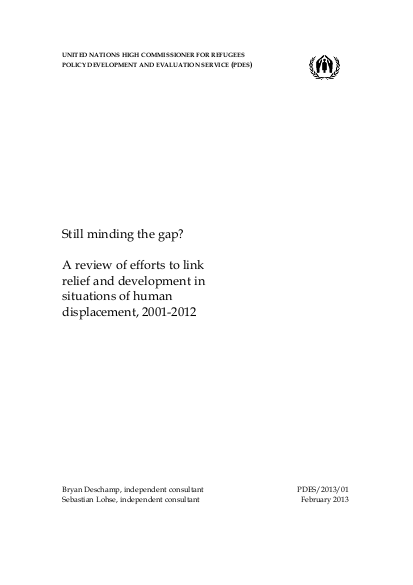
For UNHCR, the issue of involving development actors in the search for durable solutions for persons displaced by conflict, namely refugees, has a long history stretching back to the early 1980s, in particular the International Conference on Assistance to Refugees in Africa (ICARA) in 1984. More recently, especially after the UN Humanitarian Response Review of 2005, internally displaced persons have also become a regular, though distinct, feature of the search for durable solution. In addition, since late 2008, protracted refugee situations have become a focus of attention in the work of UNHCR, not only in terms of durable solutions, but also in promoting, with the help of development actors, a degree of self-reliance through livelihood activities. An overview of UNHCR’s initiatives to involve development actors from their beginnings up to the Brookings Roundtable in 1999 was the subject of a UNHCR study in 2001. This present paper complements that work by studying the same subject during the period 2001-2012. The integration/reintegration of conflict-affected populations in their country of origin is recognized as one of the more important aspects of the transition from relief to development and as an integral part of peacebuilding. The international community has become more sensitized to development challenges posed by conflict and displacement; this is inter alia reflected in the Principles for Good International Engagement in Fragile States and Situations adopted in 2007. Within the timeframe of this study, as can be seen from Annex 2, much seemingly has been accomplished in terms of policy papers, deliberations in ECOSOC and other fora, guidelines and tools, and new initiatives; but their impact on the ground has been notably limited. However, since 2008, one can see an added momentum to address this “gap” between rhetoric and reality. This paper attempts to account for this. While there might be a range of reasons for this discrepancy, one nodal one is the lack of predictable funding for transition initiatives. In spite of the creation of special transitional funding mechanisms, one still is confronted with a phenomenon of “aid orphans” created by risk-adverse development partners. The subtitle of the 2011 OECD/DAC monitoring survey of the implementation of the Principles for Engagement in Fragile States and Situations is: Can’t we do better? This could be the subtitle of this overview of UNHCR’s efforts (2001-2012) to engage development actors in the search for durable solutions for those displaced by conflict.